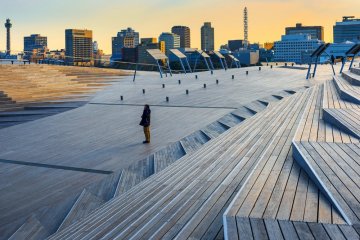
L'Hôtel Mystays Yokohama
Fanny MarechalL'hôtel MyStays Yokohama, la localisation parfaite pour explorer le bord de mer.

Considéré comme le premier parc côtier du Japon, le parc Yamashita est situé juste en face du port de Yokohama, s'étendant sur près de 700m du côté est d'Osanbashi à la jetée de Yamashita. Il a été créé à partir des restes de bâtiments détruits lors du grand tremblement de terre de Kanto et a ouvert en 1930.
Le parc comprend une prairie d'herbe, une roseraie, la statue de la «Petite fille aux chaussures rouges», la statue «Gardien de l'eau», qui est un cadeau de San Diego, ville jumelle de Yokohama, et le mémorial de la chanson «Kamome no Suihei-san "(" Seagull Sailor "), un escalier d'eau et une scène.
L'ancien cargo et navire à passagers Hikawamaru est ancré ici.
Yamashita Park is a 3-minute walk from the Motomachi-Chukagai Station (Minatomirai Line); a 1-minute walk from the Yamashita Koen-mae bus stop on City Bus #26, departing from the Sakuragi-cho Station (JR or Yokohama City Subway)

L'hôtel MyStays Yokohama, la localisation parfaite pour explorer le bord de mer.

Idéal pour les couples ou les groupes (jusqu'à 12 personnes), Masago propose une cuisine kaiseki savoureuse, délicieuse et artistique. Essayez leur cuisine classique de style japonais qui a été modifiée pour un goût plus international tout en conservant l'harmonie de ses saveurs originales.

Le Peace Cafe propose un menu végétalien délicieux et coloré. Vous ne serez pas déçu par le café d'inspiration hawaïenne où vous pourrez goûter la salade de tacos mexicaine, le tofu-katsu et le curry avec une ration supplémentaire de légumes.

Profitez d'un après-midi de thé chinois avec dim sum, shumai et boulettes de pâte à MS. CASABLANCA. Cet espace de restauration chinois décontracté est chic et confortable, offrant une cuisine chinoise haut de gamme à Kanagawa.

Kanteibyo Temple (関帝廟) is a spiritual landmark in Yokohama’s Chinatown. It shines like a beacon of faith with its vibrant red exterior and intricate detailing. Dragon statues stand above the entrance with poised bodies and open mouths, fiercely guarding the temple. The interior is decorated ornately with gold designs, wordlessly speaking of the temple’s significance. In the center sits a statue of Guan Yu, a famous military general turned deity who is immortalized in the historical Chinese novel, Romance of the Three Kingdoms. Worshippers pray to Guan Yu for business and financial prosperity. History Founded in 1862, Kanteibyo was allegedly created when a Chinese migrant brought a statue of Guan Yu to Japan. The temple started humbly as a small shrine but expanded over the years thanks to donations from devout worshippers. Kanteibyo’s history was a turbulent one, as it stood witness to numerous calamities. In 1923, the temple was destroyed by an earthquake; years later it was damaged in 1945 during World War II air raids; and in 1986, it burned down due to an unsolved fire incident. After each destructive event, the town united to rebuild the temple, reflecting the residents’ deep sense of community and connection with each other and the temple. Today Kanteibyo has become entrenched in Chinatown’s legacy and is a frequented site by residents and tourists alike for prayer and admiration. The temple is dedicated to seven deities, all of which--except the Jade Emperor who is symbolized by the ceiling--are represented by lavishly adorned statues. These deities include the Jade Emperor, Guan Yu, Di Mu Niang Niang, Zhou Cang, Guan Ping, Guan Yin, and Fu De Zheng Shen. Centered in the temple is Guan Yu’s statue, which is red-faced, long bearded, and cloaked in brightly-colored attire. The most common way of praying involves the use of incense sticks. While fire is prohibited in the main shrine, worshippers can light the incense sticks outside and place them in five burners corresponding to the shrine’s deities. After lighting the incense, practicers enter the main building and pray to the deities in a specific order. Temple assistants can also help people tell their fortunes with the use of divination moon blocks. The temple holds celebratory events throughout the year with the most popular ones being on New Year, Lunar New Year, and Guan Yu’s birthday. These spectacles are filled with traditional Chinese performances such as lion and dragon dances.

Masobyo Temple (媽祖廟), also called Ma Zhu Miao, is located in Yokohama’s Chinatown. The young Taoist temple, which opened relatively recently in 2006, enshrines Mazu, the Chinese Goddess of the Sea. Despite its young age, the temple exudes ancient spirituality older than its years. The structure has a geometrical base and is decorated with blue, green, red, and gold detailing. A massive gate welcomes visitors and worshippers alike and is connected to the main temple with a line of red lanterns. Inside Masobyo, a statue of Mazu is cloaked in vibrant attire and wearing an imperial headdress, symbolizing her godly status. The interior is equally as impressive as the outside with exquisite designs covering every surface. Worshippers commonly go to the temple to pray for safe travels since, historically, sailors and fishermen would pray to the goddess for calm seas during their journeys. History of Mazu: Goddess of the Sea As a human, Mazu was born in the tenth century and named Lin Mo. According to legend, she was gifted with supernatural abilities, such as predicting the weather, calming storms, and experiencing visions. She dedicated her life to the teachings of Tao and ascended to the heavens at age 28 as a goddess. Mazu has two demon bodyguards, Qianliyan and Shunfenger. Both demons vowed to protect Mazu after failing to defeat her in combat for her hand in marriage. Inside Masobyo, statues of the demon guardians stand to the left and right of Mazu. One, colored red, is positioned in a listening pose with his hand to his ear, while the green colored one is diligently watching, with eyes that seem to scan the temple. Today Worshippers visit Masobyo to pray to Mazu for safe travels, as well as general health and safety. The temple is also a popular spot for tourists due to its traditional architecture and cultural significance in Chinatown. Of course, Mazu’s affinity for keeping travellers safe is appealing to tourists as well. Masobyo’s temple staff are extremely helpful and more than willing to teach visitors the appropriate methods of worship. Individuals who want a closer look at Mazu’s statue are required to buy incense sticks, which they place in five burners. After lighting the incense sticks, they should bow in respect. During New Years, the temple becomes crowded with people participating and watching the festive displays.

Yokohama International Passenger Terminal, also known as Osanbashi or Yokohama Port, is located at Osanbashi Pier. Osanbashi Pier, located between Minato Mirai and Yamashita Park / Chinatown, is the most important international port terminal for Japan due to its proximity to Tokyo many cruise lines from around the world stop by. The 400 meter long pier has walkways and green spaces that are open to the public. It was originally built in 1894, but converted into a passenger terminal in 2002. The pier is one of the best places in Yokohama to get an unobstructed view of the Minato Mirai skyline. There are also shops, restaurants and a hall for small exhibitions and events here.